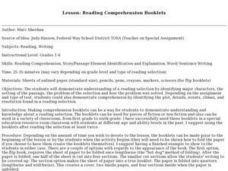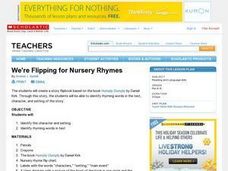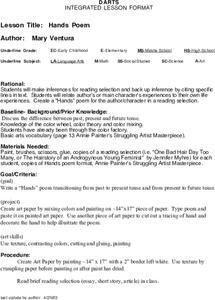Curated OER
It's My Turn to Read
Students explore reading fluency and reading with expression. They discuss four books and complete four different activities for each of the books discussed. Students read each book and act the story out using puppets, perform a reader's...
Curated OER
Reading Comprehension Booklets
Students demonstrate understanding of a reading selection by identifying major characters, the setting of the passage, the problem of the selection and how the problem was solved.
Curated OER
Printable Story Starter: Snow Leopard
This writing prompt about a hungry snow leopard provides students with the beginning of a story, including characters, a setting, and a conflict that the student can complete. The student can then compose an original middle and end of...
Curated OER
Problem & Solution Diagram
In this graphic organizer worksheet, students identify the key elements in a piece of literature. Students fill out the chart with the story's problem, character's goal, key events and the resolution.
Curated OER
Peter Pan Word Search
For this Peter Pan word search worksheet, students read 12 names of characters or settings from the famous story. Students find these in a word search puzzle.
Curated OER
Character Scrapbook Teacher's Guide
Students analyze a book's characters and create a scrapbook to print and save. In this on line interactive characterization lesson plan, students identify character traits and gain a deeper understanding of a book's characters.
Curated OER
Picturing a Story
Students view slides from the movie "Hoot" and discuss characters, setting and the caption. They identify where in the rise and fall of the plot this scene takes place. They brainstorm elements needed to create a story from a picture....
Curated OER
Fan(tom) of the Opera
Students explore the ways in which the worlds of popular music and opera can work together to complement the other. They work in small groups to analyze plot, characters, setting and themes of a popular opera using a summary of that...
Curated OER
Mental Images in Reading Comprehension
Students use textual clues to create mental images and interpret characters moods and actions. They visualize the setting, characters and events.
Curated OER
We're Flipping for Nursery Rhymes
Students read a variety of nursery rhymes with a focus on "Humpty Dumpty". While reading, they identify the words that rhyme along with the setting, plot and characters. To end the activity, they complete a Venn Diagram comparing...
Curated OER
Dr. Seuss For a Day
Second graders brainstorm words to describe Thing One and Thing Two characters from Dr. Seuss computer program, use variety of adjectives to create descriptions, and create new set of characters, Thing Three and Thing Four, by drawing...
Curated OER
Checkmate: The Play's The Thing
Students investigate the Middle Ages and it's relation to the theater. In this acting lesson, students read Arthurian stories form the Middle Ages and practice using vocabulary words from the Medieval Times. Students write a play set...
Curated OER
What Can I Write About When I Can't Think of Anything To Write About?
Third graders write, illustrate, and publish a collaborative story. In this writing lesson, 3rd graders review story elements by reading stories written by professional authors and other students. They work in groups to write a...
Curated OER
And the Moral of the Story is...
Students retell a story using computer software. In this story elements lesson, students retell the story giving the plot, setting, characters and moral using Pixie software.
Curated OER
PowerPoint Short Story Report
Students make a Microsoft PowerPoint report from a short story read in class. They summarize and paraphrase a short story identifying the six story elements: characters, setting, plot, conflict, solution, tone/mood.
Curated OER
Little Pig, Little Pig
First graders compare versions of the Three Little Pigs. In this comparison lesson, 1st graders read several version of the Three Little Pigs and compare the situations, characters, settings, solutions, emotions and costumes. Students...
Curated OER
The Diary of Anne Frank-Clash of the Clans
Middle schoolers read selected passages from The Diary of Anne Frank. They, in groups, discuss the television / movie characters and create character webs involving these characters and those in the Anne Frank book.
Curated OER
Names Count!
Second graders work in small groups to complete a graph and use data to determine range, mode, and median. They use the number of letters in their names and in fairy tale characters names to produce their data. This is a fun lesson!
Curated OER
Flight of the Imagination
Students study the success of video games by reading an online article. They work in groups to design settings, storylines, characters and technical features for their own fantasy video games. Finally, they write scripts for previews of...
Curated OER
Farm Stories, Animal Webbing, Favorite Farm Animal Graph
Students brainstorm animals they would expect to see on a farm. They save these on a Kidspiration web. Students watch or read a farm story. They discuss the characters. Students vote for their favorite farm animal and crate a graph using...
Curated OER
It's Not Just Story Time... It's Learning Time!
Students look at picture books and describe the story elements. In this picture book lesson, students retell a story and begin to understand the story elements of plot, setting, and characters. Students complete graphic organizers to...
Curated OER
TV and Teaching
Students write a story centered around their favorite TV show. In this story writing lesson, students share their favorite TV shows and discuss their favorite characters. Students draw pictures that illustrate a story in which they are a...
Curated OER
Classes For The Masses
Students explore how class is represented in the media by developing ideas for television pilots that deal with class issues. They compile short lists of television characters from working, middle and upper classes.
Curated OER
Hands Poem
Learners create a "Hands" poem for the author/character in a reading selection.They make inferences for reading selection and back up inference by citing specific lines in text. They relate author's or main character's experiences to...
Other popular searches
- Setting Plot Main Characters
- Main Characters and Setting
- Plot, Characters and Setting
- Main Character and Setting
- Plot Characters and Setting
- Setting and Characters
- Plot Setting Characters
- Setting Characters

























